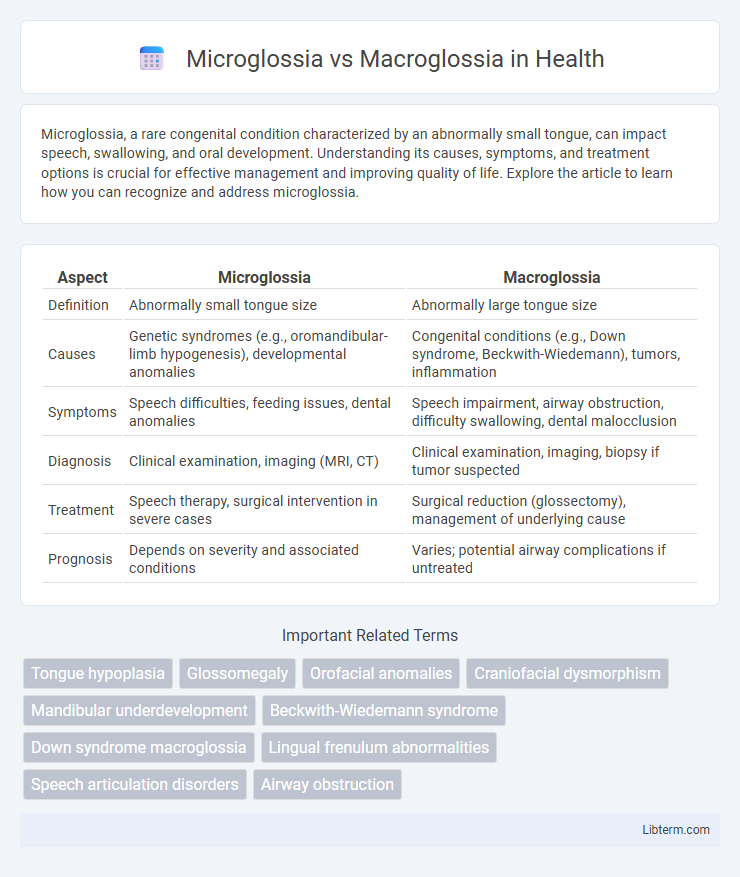Microglossia, a rare congenital condition characterized by an abnormally small tongue, can impact speech, swallowing, and oral development. Understanding its causes, symptoms, and treatment options is crucial for effective management and improving quality of life. Explore the article to learn how you can recognize and address microglossia.
Table of Comparison
| Aspect | Microglossia | Macroglossia |
|---|---|---|
| Definition | Abnormally small tongue size | Abnormally large tongue size |
| Causes | Genetic syndromes (e.g., oromandibular-limb hypogenesis), developmental anomalies | Congenital conditions (e.g., Down syndrome, Beckwith-Wiedemann), tumors, inflammation |
| Symptoms | Speech difficulties, feeding issues, dental anomalies | Speech impairment, airway obstruction, difficulty swallowing, dental malocclusion |
| Diagnosis | Clinical examination, imaging (MRI, CT) | Clinical examination, imaging, biopsy if tumor suspected |
| Treatment | Speech therapy, surgical intervention in severe cases | Surgical reduction (glossectomy), management of underlying cause |
| Prognosis | Depends on severity and associated conditions | Varies; potential airway complications if untreated |
Introduction to Microglossia and Macroglossia
Microglossia refers to an abnormally small tongue, often associated with congenital disorders such as oromandibular limb hypogenesis syndrome, leading to difficulties in speech and swallowing. Macroglossia denotes an enlarged tongue commonly caused by conditions like hypothyroidism, amyloidosis, or Down syndrome, which can result in airway obstruction and dental malocclusion. Both microglossia and macroglossia significantly impact oral functions, necessitating early diagnosis and tailored therapeutic interventions.
Definitions and Key Differences
Microglossia is a rare congenital condition characterized by an abnormally small tongue, often impeding proper speech and feeding functions, while macroglossia involves an enlarged tongue that can cause airway obstruction, dental issues, and difficulties in swallowing. The key differences lie in tongue size abnormalities, with microglossia presenting decreased tongue volume and macroglossia showing overgrowth related to genetic disorders like Beckwith-Wiedemann syndrome or acquired causes such as amyloidosis. Both conditions require accurate diagnosis through clinical examination and imaging to direct appropriate treatment strategies for functional and cosmetic improvement.
Etiology: Causes of Microglossia
Microglossia, a rare congenital condition characterized by an abnormally small tongue, often arises from genetic syndromes such as oromandibular limb hypogenesis or associated craniofacial microsomia. Vascular disruptions during embryonic development and certain teratogenic exposures contribute to its etiology, leading to impaired tongue morphogenesis. This contrasts with macroglossia, which typically results from lymphatic malformations, muscular hypertrophy, or systemic diseases like hypothyroidism or amyloidosis.
Etiology: Causes of Macroglossia
Macroglossia is primarily caused by congenital conditions such as Down syndrome, Beckwith-Wiedemann syndrome, and congenital hypothyroidism, which lead to abnormal tongue enlargement. Acquired etiologies include amyloidosis, hypothyroidism, lymphangioma, and muscular hypertrophy due to trauma or tumors. In contrast, microglossia is a rare congenital anomaly characterized by an abnormally small tongue often linked to craniofacial malformations like orofacial clefts.
Clinical Manifestations and Symptoms
Microglossia presents with an abnormally small tongue, often causing difficulties in speech, swallowing, and altered dental occlusion. Macroglossia involves an enlarged tongue that leads to airway obstruction, drooling, speech impediments, and difficulties with mastication and swallowing. Both conditions can result in impaired oral function and may require clinical evaluation for underlying causes such as congenital anomalies or systemic diseases.
Diagnostic Approaches and Assessment
Microglossia and macroglossia are diagnosed using clinical evaluation combined with imaging techniques such as MRI or ultrasound to assess tongue size and structure. Tongue measurements, patient history, and assessment of functional impairments like speech difficulty or airway obstruction are critical in differentiating between the two conditions. Electromyography and biopsy may be employed in cases where muscular or neurological etiologies are suspected, enhancing diagnostic accuracy.
Associated Syndromes and Comorbidities
Microglossia, characterized by an abnormally small tongue, is often associated with syndromes such as oromandibular-limb hypogenesis and Hanhart syndrome, frequently presenting with limb malformations and craniofacial anomalies. Macroglossia involves an enlarged tongue and is commonly linked to Beckwith-Wiedemann syndrome, Down syndrome, and hypothyroidism, contributing to airway obstruction, speech difficulties, and feeding challenges. Both conditions may coexist with systemic abnormalities, necessitating multidisciplinary management to address developmental, respiratory, and neurological comorbidities.
Treatment Strategies and Management Options
Microglossia treatment focuses on surgical correction to improve speech and swallowing function, often involving tongue expansion procedures or prosthetic devices. Macroglossia management includes surgical reduction techniques, such as partial glossectomy, to prevent airway obstruction and improve oral function, along with orthodontic support and speech therapy. Customized therapy plans integrating multidisciplinary approaches optimize functional outcomes and enhance quality of life for patients with either tongue size anomaly.
Prognosis and Potential Complications
Microglossia, characterized by an abnormally small tongue, often results in speech difficulties and feeding challenges but generally has a favorable prognosis with appropriate therapeutic interventions. Macroglossia, defined by an enlarged tongue, may cause airway obstruction, dental malocclusion, and difficulties in speech and swallowing, presenting a more complex prognosis due to potential respiratory complications. Long-term management of macroglossia often involves multidisciplinary care to prevent secondary complications such as sleep apnea and impaired craniofacial development.
Preventive Measures and Patient Care Tips
Microglossia, characterized by an abnormally small tongue, requires specialized preventive measures including regular oral examinations to monitor speech and swallowing difficulties, alongside maintaining optimal hydration to support tissue health. In contrast, macroglossia, defined by an enlarged tongue, demands vigilant airway management and routine dental assessments to prevent ulcerations and infection, emphasizing the use of custom oral appliances for comfort and function. Patient care for both conditions benefits from multidisciplinary collaboration involving speech therapists, dentists, and otolaryngologists to tailor individualized treatment plans and improve quality of life.
Microglossia Infographic

 libterm.com
libterm.com